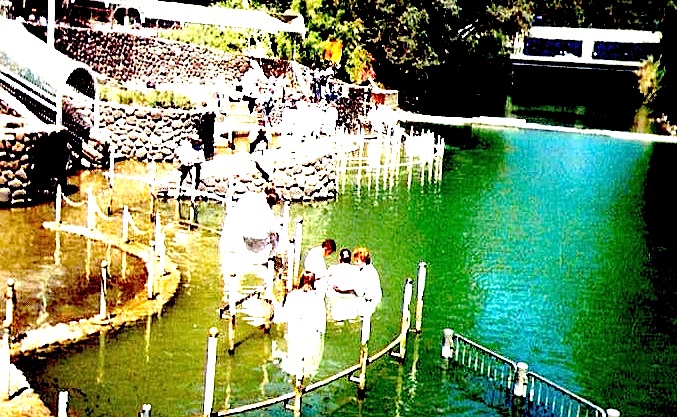Whenever I tell people how I learned to windsurf on Israel’s Sea of Galilee, I’m usually met with a bemused pause, as if a Bible-themed punchline should come next. Some zinger about Jesus walking on water, perhaps, admonishing me to drop my sail and become a windsurfer of men.
To be sure, windsurfing on the Sea of Galilee was not your typical aquatic outing. As I floated near the shore, for example, I could spot Italian pilgrims baptizing one another in the shallow water. Recently arrived Lebanese refugees strolled the lakeside in donated surfer attire, and the occasional Israeli fighter jet streaked out over the Golan Heights. At a kiosk just up the road, one could purchase kosher hot dogs, “Capernaum: Town of Jesus” baseball caps, and packets of pre-moistened towelettes called “Holy Wipes.”
Out on the water, however, away from the shore, windsurfing the Holy Land wasn’t all that different than if I’d learned the sport elsewhere: The water was cool and the breeze steady; birds soared above a rolling landscape of lakeside settlements, fruit orchards and grassy yellow fields. Fishermen plied the water in motorboats; cocoa-buttered sunbathers idled on the shore. At times, as I struggled to find the right windsurfer’s balance in the Levantine wind, I could squint my eyes and almost imagine I was in eastern Oregon.
I hadn’t traveled to the Middle East to learn how to windsurf; I’d come as a seeker of sorts, hoping to walk my way across Israel Jesus-style. Shading myself with an American-style cowboy hat, my backpack full of food and bottled water, I’d set off on a late-spring trudge toward Jerusalem. Just over a week into my journey, I was hiking along the highway south of Megiddo (a.k.a. Armageddon, the storied site of end-times saber-rattling in the Book of Revelations) when two winsome Tel Aviv girls eased their car onto the shoulder and asked me if I wanted to spend the afternoon with them on the Sea of Galilee.
Had my hike been purely an exercise in piety, I might have been obligated to refuse–especially since I’d spent the past several days hiking away from the Sea of Galilee. But, since any good pilgrimage must take into account the inspiration of a given moment (and since Hadar and Yifat were very inspirational), I was happy to heed the siren call. Two hours later I was back at my starting point, taking a windsurfing lesson near the spot where Jesus had given his Sermon on the Mount some 2000 years before.
If the Israeli girls had plucked my cowboy-hatted visage from the side of the road because it lent a sense of Thelma and Louise exoticism to their day, I surely destroyed the Brad Pitt mystique once I splashed out into the Galilean water and began to flail around on a rented board. My teacher was a deeply tanned fellow named Aryeh, who told me he one day hoped to compete for the Israeli Olympic team. (I thought of him four years later, when Gal Fridman’s Athens windsurfing victory landed Israel its first-ever Olympic gold). Since Aryeh’s English was only slightly better than my Hebrew, I never learned much about the technical aspects of windsurfing. Mostly he coached me with inspirational plaudits like, “get up, and relax on the board,” or “no, up!” or “more relax!”
When I swam ashore for a break after the first hour, the girls complimented me on my windsurfing form (“you looked like you were trying really hard not to fall off the side of a building”) and introduced me to Aaron, the white-haired Sephardim who co-owned the windsurfing operation with his daughter.
Originally from Basra, Aaron was fluent in Arabic, and had opened his campsite to the Christian Lebanese militiamen who’d accompanied the Israeli army when it had pulled out of southern Lebanon two weeks prior. The grizzled Arab mercenaries, who’d fled the Hezbollah reoccupation with little more than the clothes on their backs, looked a tad startled in their new flip flops and red-blue board shorts. “It’s all I had to give them,” Aaron told me. “I offered them windsurfing lessons, too, but nobody’s taken me up on it yet.” With Aaron translating, the mercenaries and I compared notes about the Christian shrines nearby (“Some remind you of Jesus,” one guy joked. “Some remind you of Walt Disney.”) before Aryeh took me out for another hour on the sailboard.
By late afternoon, I’d fine-tuned my falling-off-a-building sailboard technique to the point where I was bumping along the surface of the lake for minutes at a stretch. For a few moments, history, geography and biblical lore fell away; I reveled in the simple experience of wind and water and motion.
When I waded ashore at the end of the day, Hadar and Yifat asked me if I was interested in continuing to Tel Aviv and joining them at an art opening in Jaffa that evening. “If you want,” Yifat added, “you can windsurf in the Mediterranean tomorrow.”
Imagining the prophet Jonah boarding his ship in Jaffa just days before he was cast into the sea and swallowed by a whale, I piled into the Israeli girls’ car and continued my strange little pilgrimage.

